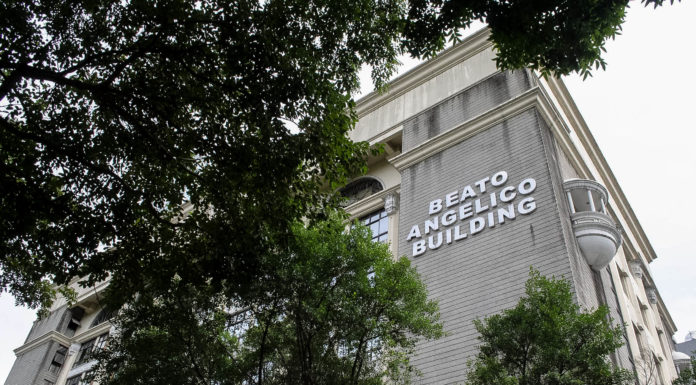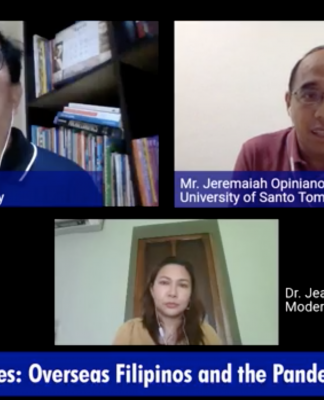ON JULY 18, 2011, the ABS-CBN show ‘XXX’ aired a complaint from a certain “Rowena” about a supposedly “blasphemous” exhibit item at the CCP Main Gallery. Program anchor Pinky Webb introduced the work as part of the ongoing media coverage about the RH bill protest. She said in effect that some works go above freedom of expression by insulting the images and beliefs of the Catholic Church.
Details where objects representing the male genitalia and actual condoms were juxtaposed with Catholic images were selected for the TV screen— these were blurred but nonetheless highlighted by the anchor’s descriptions. These selected images were shown to Commission on Human Rights head Etta Rosales, who was quick to conclude that the work is “a product of a troubled mind.” Retired Archbishop Oscar Cruz was also shown reviewing the work through a handheld monitor saying that, “It is not only sick, it is also sickening.”
Since the airing of this episode, stories about the exhibit shot up on mainstream media and social networking sites and triggered uproar from certain groups and personalities. Opinion went beyond debate on the artistic merit of the work, and actually extended to vandalism and attempted arson of the work, threats of lawsuits and drastic cuts in the CCP’s budget, and sadly, the slew of invectives, curses, character assassination and death threats hurled not just against me, but even against the Kulô exhibit organizers and CCP officials.
I don’t usually interfere with how my works appeal to the sensibilities of the audience. As a visual artist, I believe that images contain more insights than words. Images can be interpreted in various ways depending on the viewer’s perspective and imagination. Pero dahil sa kontrobersiya, nakalulungkot na nagkaroon agad ng konklusyon na ang intensyon ko o ng “Poleteismo” ay bastusin o insultuhin ang relihiyon o ang publiko.
The intention of the work "Poleteismo" is to represent the various manifestations and contradictions of idolatry in Philippine society. Idolatry—o “pagsamba” na hindi naman po tungkol lang sa relihiyon, kundi tungkol din sa iba’t iba pang aspeto ng ating kultura at lipunan. The work is a collage, or a collection of different images and materials, which in a way reflect on our culture’s search for perfection—perfection embodied by calendars with models, posters for advertising, campaign materials for politicians, diplomas signifying achievement, religious paraphernalia, photographs of celebrities, et cetera.
These are all everyday images that somehow represent the things we aspire for, or the values we identify with. It is intended to be a mirror of how we mould ourselves in a life full of opposing realities. The images are presented in consonance with the way we perceive our imagined realities—images commonly posted on worn-out walls of houses especially in impoverished areas. Karamihan po sa mga imahe ay karaniwan po nating makikita sa mga pader mismo ng mga bahay natin. Walls where we usually post diplomas, photographs, calendars, posters and other icons to represent the very image we want people to perceive of us.
The work attempts to capture the sense of irony, doubt and disillusionment that I have personally felt when reflecting on these realities. In order to convey these, I randomly juxtaposed many other images or objects which symbolize patriarchy and power, including lights, empty alcohol bottles, a halo and the much-talked about condoms na kung tutuusin po ay napakaliit na bahagi lamang ng buong komposisyon. Although I believe it should be seen as a whole, I am compelled to particularly explain some elements, lalo na po ang mga elemento o imahe na ikinakagalit ng ilang panig.
The condoms are placed randomly and are meant to represent questions on hypocrisy in our culture. The phalluses are symbols of patriarchy, power and worship as indicated in history like the obelisk seated in the center ground of the Saint Peter Basilica. To read a passage I found from the group "Watchmen on the Wall" regarding its meaning, “Originally, the obelisk was associated with sun worship. The ancients, having rejected the knowledge of the true creator, seeing that the sun gave life to plants and to man, looked upon the sun as a god, the great life giver. To them upright objects such as the obelisk also had a sexual significance. Realizing that through sexual union life was produced, the phallus was considered (along with the sun) a symbol of life. These were beliefs represented by the obelisks.”
A number of my works, past and present, have focused on religious images. Images that are very much a part of our culture and consciousness, and are actually displayed everywhere —mula sa pinakagradyosong mga Simbahan hanggang sa pinaka-aba ng mga jeepney. There are three more pieces I included aside from the collage, which reflect on structures and practices which contradict the supposed values of Christianity:
"The Altar" (Altar 2004) which is composed of plastic piggy banks inside a wooden altar— I guess, is self-explanatory. To quote John 2:16, “Get these out of here! How dare you turn my Father’s house into a market!”
The worn-out statue of "Sitting Deity" (Poon 2004) deals with modern-day idolatry, where consumerism has taken the place of worship. By merging images from the once-powerful Syrian, Babylonian, and Egyptian cultures with contemporary pop icons, I hope to emphasize the fallibility of relying on such new “Earthly Gods.”
Lastly, the cross, originally titled “Relic of My Nation (2004),” attempts to reflect on how our psyche was constructed by society, where the viewer of the work can see his or her reflection in the mirror surrounded by a halo. It attempts to convey how religion and colonization have shaped our understanding of our selves. Malinaw po na pag sinilip natin sa gitna ang krus ay hindi si Kristo ang makikita natin, maliban na lamang kung sasabihin ng sisilip na siya mismo si Kristo.
Kahit nagpaliwanag na po ako,naniniwala po ako hindi po iisa lang ang interpretasyon o paraan ng pagbasa sa mga likhang-sining. Hindi ko po makokontrol kung ano ang interpretasyon ng iba sa aking gawa.
Muli akong humihingi ng paumanhin sa publikong nasaktan o nagalit nang dahil sa kontrobersiyang ito. Naniniwala po ako na ang sining ay nag-uudyok sa atin na mag-isip at magtanong hinggil sa mga nakikita natin sa ating lipunan, kaya pinahahalagahan ko po ang inyong opinyon. Pero ang ginagawa ko pong sining ay hindi ang magpinta ng pisikal na kagandahan ng bundok o ng mga bulaklak.
Gusto ko lang pong linawin na bagamat nilayon nitong magtanong at maging kritikal, ay hindi po nilalayon ng gawa na mang-api o sadyang manakit ng kapwa. Hindi ko ito inilagay sa loob ng Simbahan o sa anumang tiyak na lugar-dalanginan. Hindi rin po ako lumapit sa media at naghanap ng publisidad; ang midya po ang naglako nito sa mas malawak na publiko kaya’t nabalitaan ninyo ito sa telebisyon, radyo, dyaryo, at iba pa.
Itinanghal po ito sa isang pangkulturang institusyon na gumagalang sa ating karapatan na magpahayag at lumikha. May sapat na babala sa pintuan ng gallery bago kayo pumasok rito; kung sa tingin nyo po ay opensiba ang eksibit, maaaring magpasya kung pupuntahan pa ito o hindi. At kung nakahanda kayong pumasok at tumingin sa mga gawa, sana’y maging handa din po sa kritikal na diskurso at talakayan sa pagbasa at pagsuri ng sining, sa halip na bumaling sa pang-aalipusta, pagbabanta at paninira. At para sa mga institusyong inaasahang mangalaga sa ating karapatan at kalayaang magpahayag, kasama na po ang mga kaibigan natin sa media—sana po ay hindi ito humantong sa censorship.
The Philippines was named after King Philip II, a Spanish monarch with a great passion for relics. The work is composed of relics I personally collected since high school—mga bagay na kinalakihan natin at mga bagay na repleksyon ng ating lipunan at ng ating mga sarili. The uproar it created may be the unconscious denial of seeing ourselves truthfully in the mirror. Ang mga katotohanan sa ating lipunan ang tunay na lumalapastangan sa ating sariling mga imahe. (The realities in our society are the real blasphemy of our own image; the blasphemy of our sacred selves.)













kudos to you mr mideo cruz. may mga tao lng tlga na nag rereact agad bago mag isip.
the apology is muchly appreciated,.. admitting the action of hurting even if it’s not intended.
pero hindi po ako sumasang-ayon kung tatawagin nyung truth/reality ang message nung art as if it is a totality. ito po’y isang parte lamang ng isang masmalawak na katotohanan o realidad.
katulad po ng pagcover ng media na focused lang dun sa sensitibong parte ng art ninyu, yung art din nyu ay limited/bias din sa pagiging ‘contempt-inspired’ o kung anu mang inspirasyon nahugot iyon.